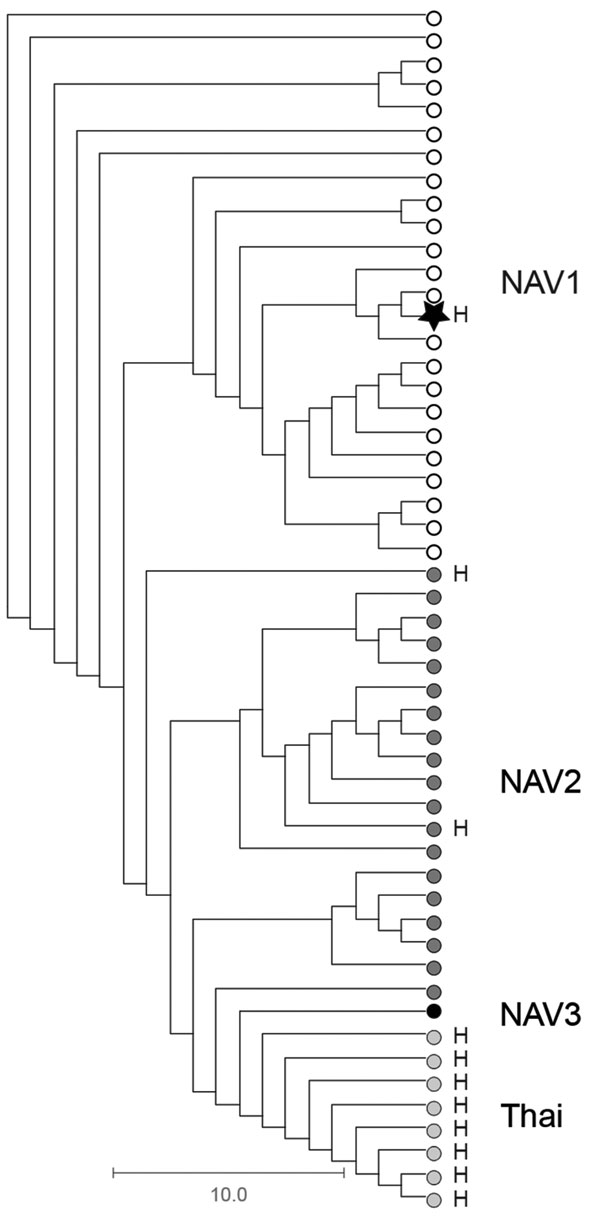Volume 23, Number 12—December 2017
Research Letter
Human Case of Streptococcus suis Disease, Ontario, Canada
Figure

Figure. Phylogenetic relationships among Streptococcus suis serotype 2 sequence type (ST) 25 isolate from a patient in Ontario, Canada (star), and 51 previously described (6) porcine and human serotype 2 ST25 S. suis isolates. The cladogram is based on nonredundant single-nucleotide polymorphism loci identified in the genome of all isolates relative to the S. suis serotype 2 ST25 core genome, as defined by Athey et al. (6). The human isolate from Ontario is genetically more closely related to serotype 2 ST25 strains of clade NAV1 (open circles), which are commonly recovered from diseased pigs in North America and which have not previously been associated with human disease, than to other serotype 2 ST25 clades from North America (NAV2, dark gray circles, and NAV3, black circle) or serotype 2 ST25 organisms from Thailand (light gray circles). Scale bar indicates nucleotide substitutions per site. H, isolates recovered from human infections.
References
- Fulde M, Valentin-Weigand P. Epidemiology and pathogenicity of zoonotic streptococci. Curr Top Microbiol Immunol. 2013;368:49–81. DOIPubMedGoogle Scholar
- Wertheim HF, Nghia HD, Taylor W, Schultsz C. Streptococcus suis: an emerging human pathogen. Clin Infect Dis. 2009;48:617–25. DOIPubMedGoogle Scholar
- Gottschalk M, Xu J, Calzas C, Segura M. Streptococcus suis: a new emerging or an old neglected zoonotic pathogen? Future Microbiol. 2010;5:371–91. DOIPubMedGoogle Scholar
- Goyette-Desjardins G, Auger JP, Xu J, Segura M, Gottschalk M. Streptococcus suis, an important pig pathogen and emerging zoonotic agent-an update on the worldwide distribution based on serotyping and sequence typing. Emerg Microbes Infect. 2014;3:e45. DOIPubMedGoogle Scholar
- Athey TB, Teatero S, Lacouture S, Takamatsu D, Gottschalk M, Fittipaldi N. Determining Streptococcus suis serotype from short-read whole-genome sequencing data. BMC Microbiol. 2016;16:162. DOIPubMedGoogle Scholar
- Athey TB, Teatero S, Takamatsu D, Wasserscheid J, Dewar K, Gottschalk M, et al. Population structure and antimicrobial resistance profiles of Streptococcus suis serotype 2 sequence type 25 strains. PLoS One. 2016;11:e0150908. DOIPubMedGoogle Scholar
- Fittipaldi N, Xu J, Lacouture S, Tharavichitkul P, Osaki M, Sekizaki T, et al. Lineage and virulence of Streptococcus suis serotype 2 isolates from North America. Emerg Infect Dis. 2011;17:2239–44. DOIPubMedGoogle Scholar
- Gottschalk M, Higgins R, Boudreau M. Use of polyvalent coagglutination reagents for serotyping of Streptococcus suis. J Clin Microbiol. 1993;31:2192–4.PubMedGoogle Scholar
- van Samkar A, Brouwer MC, Schultsz C, van der Ende A, van de Beek D. Streptococcus suis meningitis: A systematic review and meta-analysis. PLoS Negl Trop Dis. 2015;9:e0004191. DOIPubMedGoogle Scholar
- Fongcom A, Pruksakorn S, Netsirisawan P, Pongprasert R, Onsibud P. Streptococcus suis infection: a prospective study in northern Thailand. Southeast Asian J Trop Med Public Health. 2009;40:511–7.PubMedGoogle Scholar